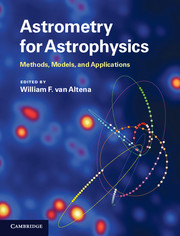Book contents
- Frontmatter
- Contents
- List of contributors
- List of acronyms
- Preface
- Part I Astrometry in the twenty-first century
- Part II Foundations of astrometry and celestial mechanics
- Part III Observing through the atmosphere
- Part IV From detected photons to the celestial sphere
- 13 Geometrical optics and astrometry
- 14 CCD imaging detectors
- 15 Using CCDs in the time-delay integration mode
- 16 Statistical astrometry
- 17 Analyzing poorly sampled images: HST imaging astrometry
- 18 Image deconvolution
- 19 From measures to celestial coordinates
- 20 Astrometric catalogs: concept, history, and necessity
- 21 Trigonometric parallaxes
- Part V Applications of astrometry to topics in astrophysics
- Index
- References
18 - Image deconvolution
from Part IV - From detected photons to the celestial sphere
Published online by Cambridge University Press: 05 December 2012
- Frontmatter
- Contents
- List of contributors
- List of acronyms
- Preface
- Part I Astrometry in the twenty-first century
- Part II Foundations of astrometry and celestial mechanics
- Part III Observing through the atmosphere
- Part IV From detected photons to the celestial sphere
- 13 Geometrical optics and astrometry
- 14 CCD imaging detectors
- 15 Using CCDs in the time-delay integration mode
- 16 Statistical astrometry
- 17 Analyzing poorly sampled images: HST imaging astrometry
- 18 Image deconvolution
- 19 From measures to celestial coordinates
- 20 Astrometric catalogs: concept, history, and necessity
- 21 Trigonometric parallaxes
- Part V Applications of astrometry to topics in astrophysics
- Index
- References
Summary
Introduction
The techniques of image deconvolution can increase your effective telescope aperture by 40% without decreasing the astrometric precision or introducing artificial bias. Some studies also show that appreciable gain in astrometric accuracy can be obtained.
Theory of deconvolution
The imaging equation
In several parts of this book it has been pointed out that astrometry, as par t of astronomy, is an observational science in which the unknown physical basis is, in our observations, convolved with the structure of the source, the emission process, the atmosphere, the telescope detector interaction, etc. In a typical exposure of the sky taken from the ground this convolution makes our point-like stars appear as pixelized extended spots of light of about one arcsecond (or more) in size. The light in the star images shows, in general, a Gaussian-like pattern but it can vary across the frame. I n all types of observations (optical imaging from the ground or space, optical and radio interferometry, etc.), the process can be mathematically described as an imaging equation which is a relationship (with an integral operator) between the distribution of the source and the distribution of the observational data.
Information
- Type
- Chapter
- Information
- Astrometry for AstrophysicsMethods, Models, and Applications, pp. 265 - 276Publisher: Cambridge University PressPrint publication year: 2012
